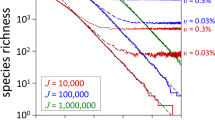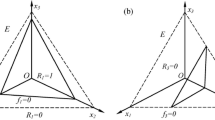Abstract
The biodiversity of plankton ecosystems may no longer be a paradox, but the mechanisms that determine coexistence of explicit competitors in ecosystems remain a mystery. This is particularly so in ecosystem models, where competitive exclusion remains the dominant process. Climate and fisheries models require plankton ecosystem sub-models that maintain competing plankton functional types extant, but coexistence can be reproduced in only a few ‘just so’ theoretical models. This limits our ability to predict the impacts of climate change and fisheries on ocean biota. We consider ecosystems of Kolmogorov form that conserve mass (CK systems). These systems describe a general class of ecosystem models that includes many theoretical and applied models. We develop heuristics that illuminate the key mechanisms that allow the coexistence of explicit competitors in these systems. These heuristics facilitate the identification of a large class of models with the structural property that all species coexist for all time. Our approach unifies many theoretical and applied models in a common biogeochemical framework, providing a powerful tool with the potential to generate new insights into the properties of complex ecosystems.





Similar content being viewed by others
References
Boyce DG, Lewis M, Worm B. 2010. Global phytoplankton decline over the past century. Nature (London) 466:591–6.
Chesson P. 2000. Mechanisms of maintenance of species diversity. Ann Rev Ecol Syst 31:343–66.
Cropp RA, Norbury J. 2009a. Parameterizing plankton functional type models: insights from a dynamical systems perspective. J Plankton Res 31:939–63.
Cropp RA, Norbury J. 2009b. Simple predator–prey interactions control dynamics in a plankton foodweb model. Ecol Model 220:1552–65.
Ebenhoh W. 1988. Coexistence of an unlimited number of algal species in a model system. Theor Popul Biol 34:130–44.
Edwards AM, Bees MA. 2001. Generic dynamics of a simple plankton population model with a non-integer exponent of closure. Chaos Solitons Fractals 12:289–300.
Emmerson M, Yearsley JM. 2004. Weak interactions, omnivory and emergent food-web properties. Proc R Soc Biol Sci B 271:397–405.
Franks PJS. 2002. NPZ models of plankton dynamics: their construction, coupling to physics, and application. J Oceanogr 58:379–87.
Gause GF. 1934. The struggle for existence. Baltimore: Williams and Wilkins.
Gross T, Edwards AM, Feudel U. 2009. The invisible niche: weakly density-dependent mortality and the coexistence of species. J Theor Biol 258:148–55.
Hardin G. 1960. The competitive exclusion principle. Science 131:1292–8.
Holling CS. 1965. The functional response of predators to prey density and its role in mimicry and population regulation. Mem Entomol Soc Can 45:3–60.
Hooper DU, Chapin FS, Ewel JJ, Hector A, Inchausti P, Lavorel S, Lawton JH, Lodge DM, Loreau M, Naeem S, Schmid B, Setala H, Symstad AJ, Vandermeer J, Wardle DA. 2005. Effects of biodiversity on ecosystem functioning: a consensus of current knowledge. Ecol Monogr 75:3–35.
Huang XC, Zhu L. 2005. Limit cycles in a general Kolmogorov model. Nonlinear Anal 60:1393–414.
Huisman J, Weissing FJ. 1999. Biodiversity of plankton by species oscillations and chaos. Nature 402:407–10.
Hutchinson GE. 1961. The paradox of the plankton. Am Nat 95:137–45.
Ives AR, Carpenter SR. 2007. Stability and diversity of ecosystems. Science 317:58–62.
Kolmogorov AN. 1936. Sulla Teoria di Volterra della Lotta per l’Esistenza. G Inst Ita Attuari 7:74–80.
Kot M. 2001. Elements of mathematical ecology. Cambridge: Cambridge University Press.
Krivan V. 2003. Competitive coexistence caused by adaptive predators. Evol Ecol Res 5:1163–82.
Law R, Morton RD. 1996. Permanence and the assembly of ecological communities. Ecology 77:762–75.
Le Quéré C, Harrison SP, Prentice IC, Buitenhuis ET, Aumonts O, Bopp L, Claustre H, Cotrim da Cunha L, Geider RJ, Giraud X, Klaas C, Kohfeld KE, Legrende L, Manizza M, Platt T, Rivkin RB, Sathyendranath S, Uitz J, Watson A, Wolf-Gladrow D. 2005. Ecosystem dynamics based on plankton functional types for global ocean biogeochemistry models. Glob Change Biol 11:2016–40.
May RM. 1973. Stability and complexity in model ecosystems. Princeton: Princeton University Press.
May RM, Leonard WJ. 1975. Nonlinear aspects of competition between three species. SIAM J Appl Math 29:243–53.
McCann KS. 2000. The diversity–stability debate. Nature 405:228–33.
McCann KS, Hastings A. 1997. Re-evaluating the omnivory–stability relationship in food webs. Proc R Soc Lond B 264:1249–54.
McCann KS, Hastings A, Huxel GR. 1998. Weak trophic interactions and the balance of nature. Nature 395:794–8.
Montes-Hugo M, Doney S, Ducklow HW, Fraser W, Martinson D, Stammerjohn SE, Schofield OME. 2009. Recent changes in phytoplankton communities associated with rapid regional climate change along the Western Antarctic Peninsula. Science 323:1470–3.
Namba T, Tanabe K, Maeda N. 2008. Omnivory and stability of food webs. Ecol Complex 5:73–85.
Ohman MD, Hirche H-J. 2001. Density-dependant mortality in an oceanic copepod population. Nature 412:638–41.
Petrovskii SV, Li B-L, Malchow H. 2003. Quantification of the spatial aspect of chaotic dynamics in biological and chemical systems. Bull Math Biol 65:425–46.
Power ME, Tilman D, Estes JA, Menge BA, Bond WJ, Mills S, Daily G, Castilla JC, Lubchenco J, Paine RT. 1996. Challenges in the quest for keystones. Bioscience 46:609–20.
Rose K, Allen JI, Artioli Y, Barange M, Blackford J, Carlotti F, Cropp R, Daewel U, Edwards K, Flynn K, Hill S, HilleRisLambers R, Huse G, Mackinson S, Megrey B, Moll A, Rivkin R, Salihoglu B, Schrum C, Shannon L, Shin Y, Lan Smith S, Smith C, Solidoro C, St. John M, Zhou M. 2010. End-to-end models for the analysis of marine ecosystems: challenges, issues, and next steps. Mar Coast Fish 2:115–30.
Ruan S, Ardito A, Ricciardi P, DeAngelis DL. 2007. Coexistence in competition models with density-dependent mortality. C R Biol 330:845–54.
Sarnelle O, Wilson AE. 2008. Type III functional response in Daphnia. Ecology 89:1723–32.
Schippers P, Verschoor AM, Vos M, Mooij WM. 2001. Does “supersaturated coexistence” resolve the “paradox of the plankton”? Ecol Lett 4:404–7.
Spitz YH, Moisan JR, Abbott MR. 2001. Configuring an ecosystem model using data from the Bermuda Atlantic Time Series (BATS). Deep Sea Res II 48:1733–68.
Steele JH, Henderson EW. 1992. The role of predation in plankton models. J Plankton Res 14:157–72.
Tilman D. 2007. Interspecific competition and multispecies coexistence. In: May RM, McLean A, Eds. Theoretical ecology. Oxford: Oxford University Press. p 257.
Vallina SM, Simo R, Popova EE, Anderson TR, Gabric A, Cropp RA, Pacheco JM. 2008. A dynamic model of ocean sulfur (DMOS) applied to the Sargasso Sea: simulating the dimethylsulfide (DMS) summer paradox. J Geophys Res (Biogeosciences) 113:G01009. doi:01010.01029/02007JG000415.
Acknowledgments
We thank the Zilkha Trust, Lincoln College, Oxford for financial support for this research. We also thank Michael Landry, Jim Grover and an anonymous reviewer for their constructive comments that led to substantial improvements to the original manuscript.
Author information
Authors and Affiliations
Corresponding author
Additional information
Author Contributions
Both authors contributed equally to this article.
Electronic supplementary material
Below is the link to the electronic supplementary material.
Rights and permissions
About this article
Cite this article
Cropp, R., Norbury, J. The Mechanisms of Coexistence and Competitive Exclusion in Complex Plankton Ecosystem Models. Ecosystems 15, 200–212 (2012). https://doi.org/10.1007/s10021-011-9503-1
Received:
Accepted:
Published:
Issue Date:
DOI: https://doi.org/10.1007/s10021-011-9503-1




